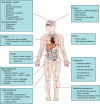Diagnosis and treatment of mitochondrial myopathies
- PMID: 21867371
- PMCID: PMC3581062
- DOI: 10.3109/07853890.2011.605389
Diagnosis and treatment of mitochondrial myopathies
Abstract
Mitochondrial disorders are a heterogeneous group of disorders resulting from primary dysfunction of the respiratory chain. Muscle tissue is highly metabolically active, and therefore myopathy is a common element of the clinical presentation of these disorders, although this may be overshadowed by central neurological features. This review is aimed at a general medical and neurologist readership and provides a clinical approach to the recognition, investigation, and treatment of mitochondrial myopathies. Emphasis is placed on practical management considerations while including some recent updates in the field.
Figures


References
-
- Chinnery PF, DiMauro S, Shanske S SchonEA. Zeviani M, Mariotti C, et al. Risk of developing a mitochondrial DNA deletion disorder. Lancet. 2004;364:592–6. - PubMed
-
- Chinnery PF, Thorburn DR, Samuels DC, White SL, Dahl HM, Turnbull DM, et al. The inheritance of mitochondrial DNA heteroplasmy: random drift, selection or both? Trends Genet. 2000;16:500–5. - PubMed
-
- Sarnat HB, Marin-Garcia J. Pathology of mitochondrial encephalomyopathies. Can J Neurol Sci. 2005;32:152–66. - PubMed
-
- Schaefer AM, McFarland R, Blakely EL, He L, Whittaker RG, Taylor RW, et al. Prevalence of mitochondrial DNA disease in adults. Ann Neurol. 2008;63:35–9. - PubMed
Publication types
MeSH terms
Substances
Grants and funding
LinkOut - more resources
Full Text Sources
